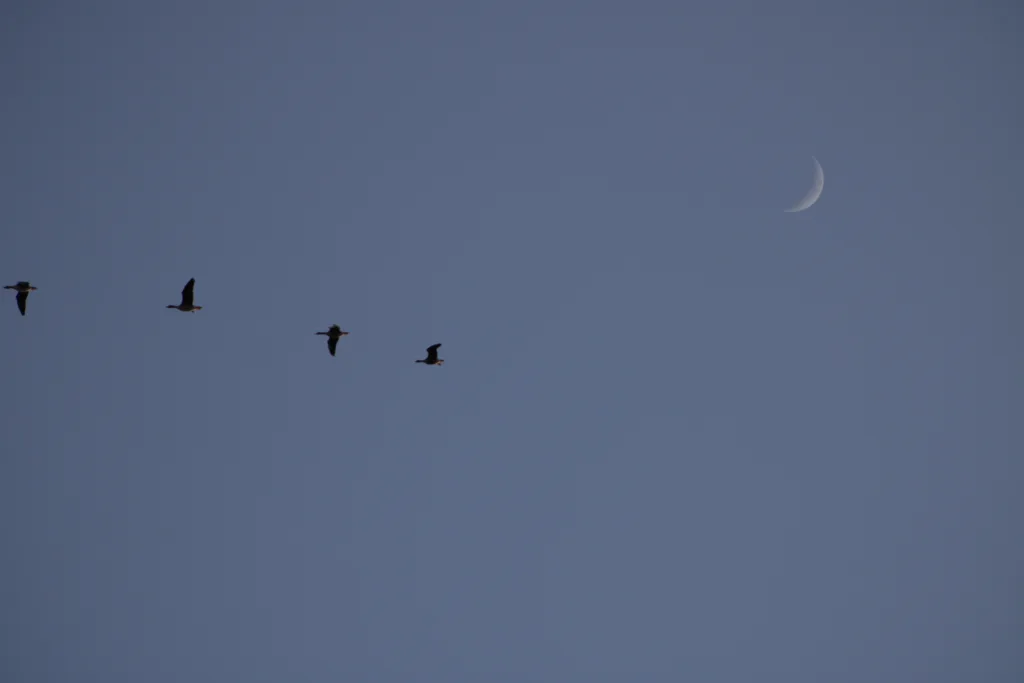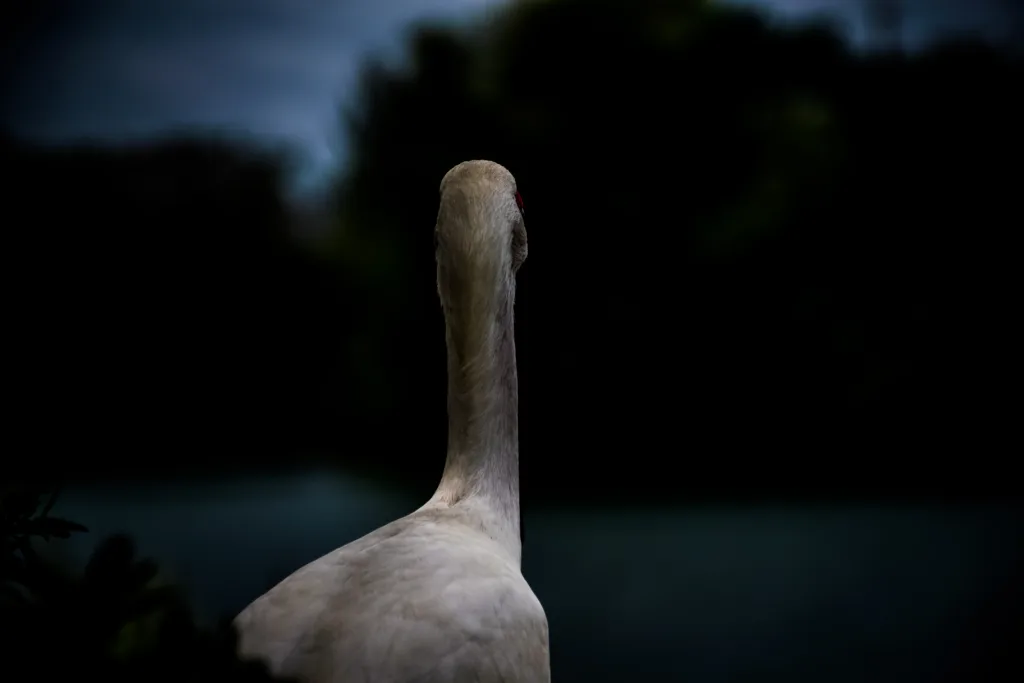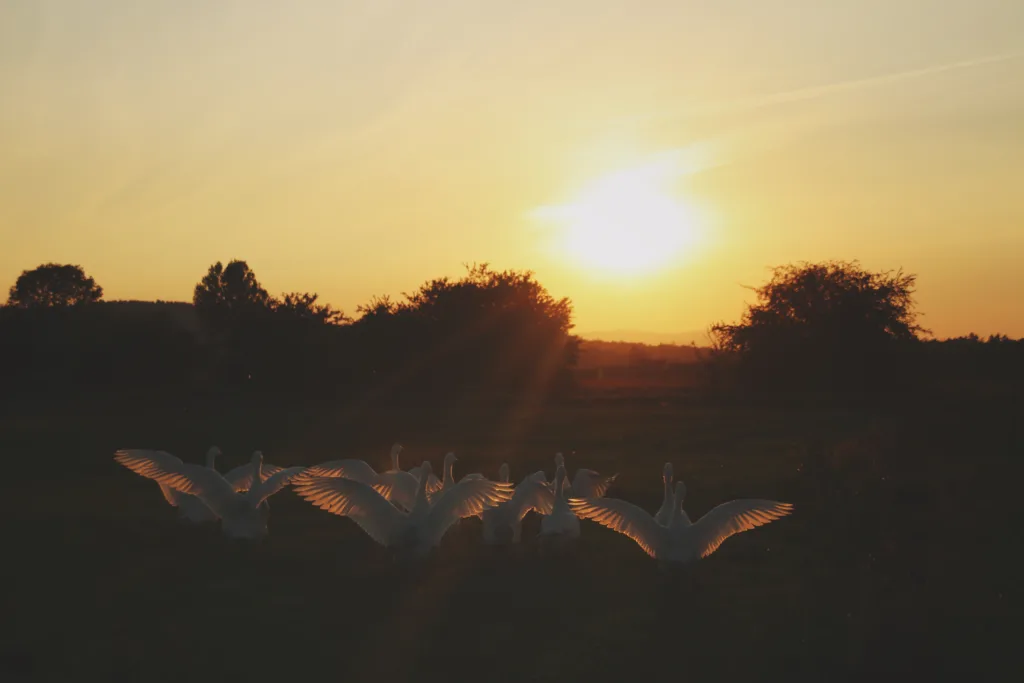Geese are fascinating birds that are known for their distinctive honking sound and their ability to fly in a V-formation. But did you know that geese also have nearly two dozen different honks that serve different purposes? In fact, voice recognition is so important to geese that it allows a temporarily lost goose to locate and rejoin family members amng a flock of thousands.
Geese are also known for their unique sleeping habits. While they rarely sleep in nests, they do sleep on both water and land. However, geese in the wild prefer to sleep on the water as it provides a sense of safety from predators. On land, they only sleep when they feel safe enough to do so.
One of the most interesting things about geese is their migratory patterns. Geese are known to migrate at night, using stars, the moon, and polarized light to navigate. This ability to navigate in the dark is crucial for the survival of the species, as it allows them to travel long distances and find new food sources.
But do geese really fly at night? The answer is yes, they do. In fact, researchers have found that geese often migrate at night to avoid predators and take advantage of cooler temperatures. This allows them to conserve energy and travel more efficiently.
During migration, geese also use their honking sound to communicate with each other and maintain the integrity of the flock. The V-formation in which they fly is also thought to help with co-ordination and position shifts. Honking one’s position is a trade-off for geese, as it helps save energy for the flock as they fly.
Geese are fascinating birds with unique behaviors and abilities. From their honking calls to their migratory patterns, there is much to learn and appreciate about these fascinating creatures. And yes, they do fly at night, using their instincts and abilities to navigate and survive.
The Mystery of Nighttime Goose Honking
Geese are known to be social creatures that communicate with each other through a variety of honks, calls, and vocalizations. While they are active during the day, geese may also honk at night for a few reasons. One of the most common reasons is to maintain contact with their flock or family group. During migration, geese may fly over long distances at night, and honking helps them stay together and avoid getting lost.
Another reason why geese may honk at night is to warn others of potential danger. Geese are territorial birds and will fiercely defend their nests and young ones, so if they sense any threat or danger, they will sound the alarm to alert others in the group. This can include predators or other animals that may pose a risk, as well as humans who may be approaching their nesting or feeding areas.
Finally, geese may also honk at night as a way of communicating with other birds in the area. This can be espeially important during the breeding season when males may be trying to attract a mate or establish their territory. Overall, honking is a vital part of geese’s communication and social behavior, and it serves a variety of important functions both during the day and at night.

Where Do Geese Spend the Night?
Geese typically go to sleep at night on the water, especially in the wild. They feel more secure sleeping on the water as it provides them with a sense of safety from predators. However, when they feel threatened or unsafe, they may choose to sleep on land instead. It’s important to note that geese do not sleep in nests, but rather rest thir heads under their wings while standing or floating in the water. So, if you happen to see a group of geese sleeping peacefully on the water, it’s safe to assume that they have found a safe and secure place to rest for the night.
Do Geese Fly at Night?
Geese are known for their long migratory journeys which they undertake to find suitable breeding and feeding grounds. They are often observed flying in a V-formation, covering hundreds or even thousands of miles durng their journey. It is not uncommon for geese to fly at night, including at 1am, as they have evolved to use various natural cues to navigate during their migration. These cues include stars, the moon, and polarized light which they use to orient themselves in the right direction. Flying at night also helps geese avoid predators and take advantage of cooler temperatures. Therefore, it is quite possible for geese to be flying at 1am during their migration.
The Significance of Geese Honking While Flying
Geese honk when they are flying for various reasons. Researchers blieve that the honking sound is primarily used to maintain the integrity of the flock and to co-ordinate position shifts with the V-formation in which they fly. The honking helps the geese to communicate with each other, and it also allows them to stay in formation, which is important for their survival during migration. Additionally, honking helps geese to conserve energy by allowing them to fly in a more efficient manner. By honking, geese can signal to other members of the flock to adjust their position, which reduces the amount of wind resistance that each individual experiences. This way, geese can fly further and for longer periods of time without getting tired. Overall, honking is a crucial part of a goose’s communication and navigational system, and it plays a vital role in their survival during migration.
Night Vision in Geese
No, geese are not blind at night. In fact, geese have excellent night vision that is more than ten times greater than ours. This ability is particularly useful for wild geese, who often fly at night when it is cooler. Domestic geese may not fly, but they too have good night vision that helps them navigate their surroundings. Therefore, geese are not blind at night and are capable of seeing well in low-light conditions.

Do Geese Require Nighttime Confinement?
Yes, geese need to be shut in at night. While geese are excellent at protecting their territory and fending off predators during the day, they have very poor night vision. This means that they are more vulnerable to attacks from nocturnal predators such as foxes, raccoons, and owls. To ensure the safety of your geese, it is important to lock them up in a secure coop or pen at night. This will not only protect them from predators but also provide them with a safe and comfortable place to rest and sleep. Additionally, locking your geese up at night can prevent them from wandering off and getting lost or injured. Therefore, it is recommended to establish a routine of locking up your geese safely at night to keep them secure and healthy.
Flight Patterns of Geese
Geese typically start to fly at some point in the morning, after milling about as the sun rises. They may sometimes head out before sunrise, but often wait until sunrise or even later to lift off. Unlike ducks, who may fly early in the morning, geese tend to fly later, usually waiting until the morning has fully set in. They generally fly to a feeding area, which is usually a field, to forage for food.
Where Do Geese Go After Dark?
Geese are known to sleep in the water, usually in groups. During the night, a few geese take turns to stay awake and act as sentinels, watching out for predators. This is a survival strategy that helps protect the geese from being attacked while they are sleeping. Sleeping in the water also makes it difficult for predators to reach them, as any attempt to do so would cause a lot of splashing and create warning ripples. Therefore, geese often choose to rest in water bodies such as lakes, ponds or rivers, where they can sleep soundly and safely.
The Length of Time Geese Fly Without Stopping
Geese are known for their impressive migratory flights, wich can last for days without stopping. The length of time that geese can fly without stopping varies depending on a number of factors, such as their age, physical condition, and the weather conditions. On average, geese can fly for up to 16 hours without stopping, covering a distance of around 1,000 miles. However, during migration, they may fly continuously for up to 24 hours, covering a distance of up to 1,500 miles. It is important to note that geese will typically take breaks during their flights to rest and refuel, especially if they encounter bad weather conditions. Overall, geese are incredible fliers that are able to endure long flights over great distances, making them one of the most impressive migratory birds in the world.

Do Birds Fly at Night?
Yes, there are birds that fly at night. While owls are the most well-known nocturnal birds, there is a group of birds called nightjars that are also active during the nighttime hours. Nightjars are typically most active at dawn and dusk, but they can also be active throughout the night. These birds feed on moths and other large insects and have adapted to hunting in low light conditions. So, while the majority of birds are diurnal, there are some species that have evolved to be active during the night.
Do Canadian Geese Come Out at Night?
Yes, Canadian geese are known to come out at night. In fact, they are classified as nocturnal migrants, which means that they prefer to migrate during the night. This is because the cooler temperatures and calmer winds make it easier for them to fly long distances. Additionally, flying at night helps them avoid predators that are more active during the day. While you may still see Canadian geese during the day, it is more likely that they will be resting, feeding, or preparing for their next night flight.
Can Birds Fly in the Dark?
Yes, some birds are capable of flying in the dark. However, it’s not very common for most birds to fly at night unless they are disturbed or threatened. Nocturnal birds, such as owls and nightjars, are adapted to fly and hunt in the dark. They have excellent night vision and rely on their keen hearing to locate prey. In addition, some migratory birds, such as songbirds, also fly at night dring their long journeys. They use the stars and other celestial cues to navigate and orient themselves. However, it’s worth noting that flying in the dark can be risky for birds as they may collide with obstacles or become disoriented. Therefore, most birds prefer to rest and sleep at night, especially during the breeding season when they need to conserve energy for raising their young.
Do Geese Recognize Human Faces?
Yes, geese have a remarkable memory and are capable of remembering people, animals, and situations for a long time. In fact, geese are knon to have one of the most impressive memories of all bird species. They can remember and recognize their own kind, as well as humans and other animals they have interacted with in the past.
Geese can also remember specific locations, routes, and even sounds associated with certain people or events. This is why they make excellent watch animals, as they can easily spot and alert their owners of unfamiliar or potential threats.
Studies have shown that geese can remember people for years, and even after long periods of separation, they can recognize familiar individuals. They are also known to display signs of affection and attachment towards their owners, which can further strengthen their memory of them.
In conclusion, geese do remember people, and their remarkable memory is one of the reasons why they make great watch animals and loyal companions.

Decision-Making Process of Geese When Choosing Flying Partners
Geese are highly social birds that typically fly in flocks or groups. When it comes to deciding who to fly with, geese tend to stick with their family members or mate for life. However, if a goose loses its mate, it will often join another flock or pair up with another goose.
Geese also have a strong instinct to fly in formation, which helps them conserve energy and maintain communication with one another. In a flock, thre is often one dominant goose who takes the lead in the formation. However, this position is not permanent, and geese will take turns leading the flock to avoid fatigue.
When geese are looking to join a new flock or form a new pair bond, they will often engage in courtship behavior such as honking, head bobbing, and wing flapping. If the courtship is successful, the geese will fly together and stay together until the end of the breeding season.
Overall, geese rely on strong social bonds and instinctual behaviors to decide who to fly with. Whether it’s sticking with family members or taking turns leading the flock, geese work together to ensure their survival and success.
The Unexplained Phenomenon of Geese Flipping Upside Down While Flying
Geese flip upside down while flying as a technique called ‘whiffling’. This manoeuvre allows them to rapidly lose speed and height, making their landing faster and smoother. The process involves rolling their body upside down and twisting their neck to keep their head in the right position. This technique is especially useful when geese need to land quickly and efficiently, such as when they are approaching their nesting site or avoiding predators. Therefore, whiffling is an essential skill that helps geese navigate the skies and survive in their natural habitat.
Conclusion
In conclusion, geese are fascinating birds with unique characteristics and behaviors. Their ability to communicate through a variety of honks and calls, as well as their use of voice recognition to locate family members, is truly remarkable. Geese’s sleeping habits on water and land, and their reliance on stars, the moon, and polarized light to navigate during migration, are also noteworthy. Furthermore, the honking sound they make whle flying helps maintain the integrity of the flock and coordinate position shifts in the V-formation. Overall, geese are a true wonder of nature and studying their behavior can provide valuable insights into the animal kingdom.
